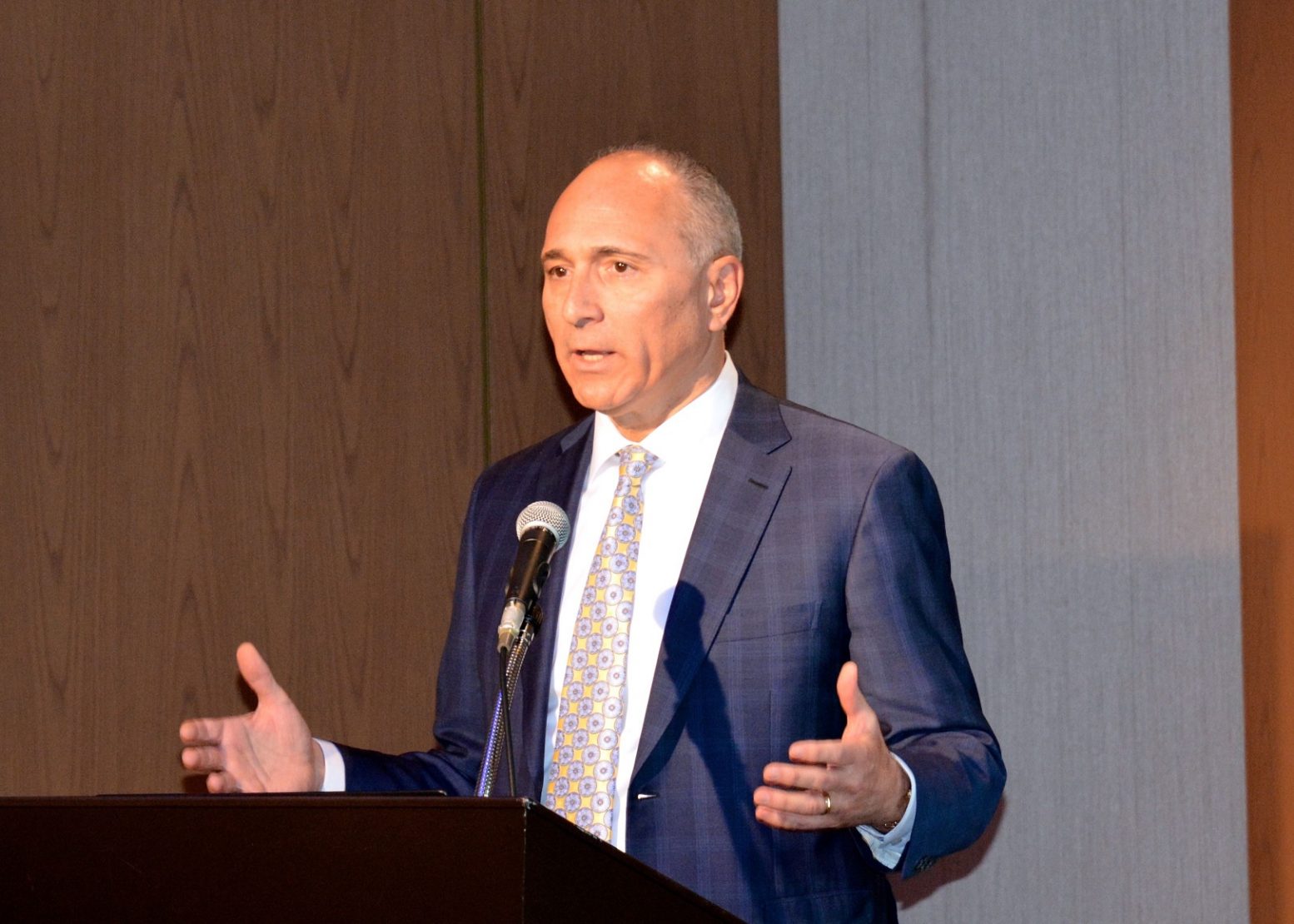Tokyo (SCCIJ) – At the October luncheon with almost 70 members and guests of the SCCIJ, Mr. Joseph Jimenez, the Chief Executive Officer of the Swiss pharmaceutical giant Novartis, painted a broad picture of the current transformation in the global health industry. Pharmaceutical innovation would fundamentally change the practice of medicine and also cause the pharmaceutical companies to evolve how they innovative, sell and operate. The recent transformation of Novartis would give some answers to this challenge, Jimenez said.
Finding new solutions for the elderly
Mr. Jimenez started his lecture with the statement that the transformative process in the health industry has already started. Examples are the artificial growth of organs for transplants, the use of the immune system to fight cancer and gene editing to heal diseases. Also, machine learning would enable smarter diagnostics. “The intersection of biology and technology will dramatically impact patients everywhere,” the speaker claimed.
“This transformation could not come at a better time because the world is getting older and bigger with chronic diseases causing more than 70 percent of deaths”, he said. For the first time in human history, one in three humans is over 50 years old. Japan would also be at the crossroads with 2 million people over 90 years old. Dementia cases would grow in Japan to 7 million by the year 2025. “Thus, we need to urgently find new solutions to treat the elderly”, Jimenez said.

SCCIJ October Luncheon speaker Mr. Joseph Jimenez, CEO Novartis
Massive opportunities of pharma innovation
These trends would drive demand but also put enormous strain on global health systems. “If unchecked, healthcare spending is forecast to double by 2030 from today which means increased pressure on pricing and access,” he explained. The good news would be that technology is creating an explosion of innovation. “We will have a renaissance in innovation and see more innovation in the next 10 years than in the previous 50 years!”, Jimenez argued.
For example, molecular biology would gain better insights in root causes of diseases. Out of 1,800 druggable proteins, only 600 are addressed by currently approved therapies. “This is a massive opportunity to treat new diseases,” he said. At Novartis, the management would believe in the transformative power of technology. Thus, the company just created the position of Chief Digital Officer. “This sounds a bit odd, but he is going to look at how we operate and how that can be transformed using digital technology”, he explained.
Another example is the leveraging of predictive analysis to make critical decisions. In collaboration with Quantumblack, Novartis gained real time insights into its clinical trials by using high quality data of the former 1 million participants. “When we recently needed clinical trials for a new drug we were looking at 120 sites to get enough patients,” he told the audience.
“But by analyzing the data with artificial intelligence, we were able to reduce this number to seven sites where we would already get 85 percent of the patients we needed,” he told the audience. That saved millions of dollars and simplified the execution of the clinical tests.

Honorary President, members and advisors of SCCIJ Executive Committee with speaker Jimenez
How Novartis is leading the next wave of innovation
The Swiss pharmaceutical company is investing heavily in research and development. Last year it spent $9 billion. About 6,000 scientists are involved in research alone. In addition, there are the Novartis Institutes of Biomedical Research. The latest institute has just been opened in Shanghai, China. As a result, Novartis is currently exploring 90 new medicines and has 40 potential filings for approval. Parallel to the focus on innovative medicine, the group company Sandoz generics can lower the total costs of health care with generic versions of Novartis drugs after the patent protection has ended. The third big business is Alcon eyecare which serves the increasing aging population.
“This R&D commitment has changed the practice of medicine,” the Novartis CEO said. For example, Glivec was the first targeted drug which allowed patients of chronic leukemia a normal life expectancy. Also, Novartis recently received approval for the anti-cancer medicine Kymriah. “This is a new defining moment for cancer treatment”, Jimenez said proudly. “We train the T-cells to kill the cancer and these killer cells even multiply in the body.”
Novartis started outcome-based pricing model
The new challenge would be that health budgets are becoming constrained. “Thus, we need to start thinking about the value the medicine brings, and not about the costs,” he said. Therefore, Novartis would try to shift from the transactional model to an outcome-based model. For example, the company entered into an agreement in the US that if the child patient of a cell therapy has not reached complete remission after 30 days, then the hospital does not need to pay Novartis for the drugs.
“I really believe that this is the future of health care,” Jimenez said. Outcome-based pricing would take 25 percent of the costs out of these systems. Novartis already had multiple such contracts in Germany, Great Britain, France, Switzerland, Italy and Spain. Not all players would be willing to engage because it requires them to track whether the patients’ health improved or not. “But it is a coming trend and in 20 years this is going to be the standard,” he said.
Biography of the speaker
Mr. Joseph Jimenez has been CEO of Novartis since 2010. Under his leadership, Novartis has developed one of the largest pipelines of self-originated drugs in the industry, driven by a commitment to R&D. Mr. Jimenez has also transformed the company’s portfolio to focus on innovative patented medicines under Novartis Pharmaceuticals and Novartis Oncology, generics under Sandoz, and eye care devices under Alcon.
Prior to serving as CEO of Novartis, Mr. Jimenez held the position of Division Head, Novartis Pharmaceuticals. He joined Novartis in 2007 as Division Head, Novartis Consumer Health. He graduated in 1982 with a bachelor’s degree from Stanford University and in 1984 with a Master of Business Administration from the University of California, Berkeley, both in the US.
Text and photos: Martin Fritz for SCCIJ





























